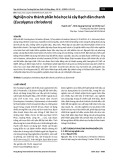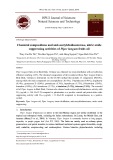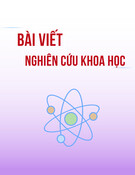
HPU2. Nat. Sci. Tech. Vol 02, issue 02 (2023), 41-47
HPU2 Journal of Sciences:
Natural Sciences and Technology
journal homepage: https://sj.hpu2.edu.vn
Article type: Research article
Received date: 15-8-2023 ; Revised date: 31-8-2023 ; Accepted date: 31-8-2023
This is licensed under the CC BY-NC-ND 4.0
Chemical components and anti-acetylcholinesterase activity of
Piper lolot leaves oil
Thuy-Van Do Thi
a,*
, Ngoc-Linh Nguyen
b
, Anh-Hung Nguyen
c
a
Department of Chemistry, The University of Danang-University of Science and Education, 459 Ton Duc Thang,
Da Nang, Vietnam
b
Faculty of Training Bachelor of Practice, Thanh Do University, Kim Chung, Hoai Duc, Ha Noi, Viet Nam
c
Department of Chemistry Hanoi Pedagogical University 2, 32 Nguyen Van Linh, Phuc Yen, Vinh Phuc, Vietnam
Abstract
Essential oil of Piper lolot leaves in Quang Nam-Da Nang do obtain via the steam distillation method
with oil collection efficiency reaching 0.68%. The chemical components of the essential oil from Piper
lolot leaves in Quang Nam-Da Nang are determined via the GC-MS method that includes 20
compositions (99.97%), among which the main compositions are myristicin (72.70%), asarone
(5.16%), β-bisabolene (3.59%), γ-asarone (3.52%), caryophyllene (2.63%), and α-copaene (1.93%).
The essential oil of Piper lolot leaves in Quang Nam-Da Nang also showed potent anti-
acetylcholinesterase activity with IC
50
(µg/mL) = 28.72±2.80 compared to galantamine (a positive
control) and essential oils, extract from Piper species.
Keywords:
Piper lolot leaves oil, Piper lolot, steam distillation, chemical components, anti-
acetylcholinesterase;
1. Introduction
Vietnam is located in the tropical monsoon region where natural conditions are favorable for the
formation and development of plants, especially high-value essential oil-bearing plants. The essential
oils have a unique aroma and fragrance that can improve relaxation, comfort, and pleasure. These
distillates possess many medicinal properties which can be applied to medicine production and
* Corresponding author, E-mail: dttvan@ued.udn.vn
https://doi.org/10.56764/hpu2.jos.2023.2.2.41-47

HPU2. Nat. Sci. Tech. 2023, 2(2), 41-47
https://sj.hpu2.edu.vn 42
antimicrobial and antiviral agents (Vergis et al., 2015; Tariq et al., 2019). Piper species are widely
used in folk medicine to heal wounds and reduce swelling and skin irritation (Gardner RO, 2010).
Piper lolot (Piperaceae), a popular vegetable in Vietnam, is also a special spice and effective
medicine. The entire plant possesses anti-inflammatory and anodyne properties. It is used in the
treatment of rheumatism, ostealgia, lumbago, headache, hyperhidrosis of the extremities, dyspepsia,
vomiting, flatulence, colic, diarrhea, toothache, chronic catarrhal rhinitis and edema (Dung NX, 2013).
Piper lolot leaves contribute positive health effects on exhibiting warmth and pain relief (Loi DT,
2003; Lau TV, 2017).
Alzheimer's disease is a devastating neurodegenerative disorder with grave concerns in the
elderly. The disease is characterized by the deposition of amyloid-β plaques and neurofibrillary tangles
in the brain, accompanied by synaptic dysfunction and neurodegeneration. Due to the required long-
term care and management, these seriously impacts the patient's health and quality of life and burdens
the family and society. It has been demonstrated that the neuropsychological impairments of
Alzheimer's disease are attributed, at least partially, to cholinergic disturbance. Rivastigmine and
galantamine derived from natural products are commonly prescribed cholinergic enhancers as
acetylcholinesterase (AChE) inhibitors (Xiang CP et al., 2017). Aromatic plants have been used to
cure neuronal ailments for centuries by different cultures worldwide. Such plant's essential oils and
volatile compounds might be potential drugs for Alzheimer's disease therapies.
Several studies have examined Piper lolot leaves oil's chemical compositions and biological
activities (Dung NX et al., 2013; Thuyen NTB et al., 2020; Phong HX et al., 2022). However, there
have been no published on Piper lolot leaves oil's anti-acetylcholinesterase activity.
The present study aimed to determine the chemical components and anti-acetylcholinesterase
activity of Piper lolot leaves oil collected from Quang Nam-Da Nang.
2. Materials and methods
2.2. Materials
The fresh leaves of Piper lolot were collected at Quang Nam-Da Nang, Vietnam, in June 2022.
The sample used for steam distillation is of uniform quality and without spoilage and stored in a cool
place. After harvesting, the fresh sample is processed with preliminary treatment, removed impurities
washed, and pureed before essential oil extraction.
Its scientific name was identified by Dr. Quang-Dan Tran, Department of
Biology&Environmental Science, The University of Danang-University of Science and Education. A
voucher specimen No. PL001 was deposited at the Department of Chemistry, The University of
Danang-University of Science and Education.
2.3. The steam distillation method
Piper lolot leaves oil was obtained by steam distillation with light Clevender with 250 g Piper
lolot leaves/500 mL distilled water for three hours at the Chemistry laboratory, The University of
Danang-University of Science and Education. The experiment was repeated three times.
The oil collection efficiency is calculated according to the amount of essential oil in the raw
materials, which is determined by the formula:
Y (%)= ×
× 100

HPU2. Nat. Sci. Tech. 2023, 2(2), 41-47
https://sj.hpu2.edu.vn 43
In which: Y(%): The oil collection efficiency; V (mL): Volume of essential oil; d (g/cm3):
Specific gravity of Piper lolot leaves oil, d = 0.995 g/cm3; m (g): Weight of the fresh leaves of Piper
lolot.
2.3. Analysis of the chemical components
The chemical components of the essential oil from Piper lolot leaves are determined via the GC-
MS method with GC-MS equipment (GC 7890A, MS 5975C-Agilent).
For GC: Operating temperature: 35oC-450oC, temperature resolution: 1oC, maximum heating
speed: 0.1oC-120oC/min, the maximum run time for sample: 999.99 minutes, speed line: 1-13 mL/min
for Helium, column type: HP-5MS (Length: 30 m, diameter: 0.25 mm, film: 0.25 μm).
For MS: EI with m/z: 20 – 500 amu, retention time repeatability with a trace: < 0.0012 min, area
repeatability with a trace: < 2.0 RSD. The percentage of a compound is based on the ratio of
compound pick area to total pick area.
2.4. Determine the anti-acetylcholinesterase activity
The test was performed according to the method of Ellman GL et al., 1961.
The method is carried out according to the principle: Acetylcholinesterase (AChE) is a catalyst
for the hydrolysis reaction acetylthiocholine iodide (ACTI) produces thiocholin. The thiocholin will
react with DTNB (acid 5-5’-dithiobis-2-nitrobenzoic) to form a yellow 5-thio-2-nitro benzoic acid.
The amount of this color compound is proportional to AChE activity. The experiment was repeated
three times. As follows:
- The experimental sample was dissolved in 100% DMSO solvent, then diluted to different
concentrations with H2O (deionized distilled water).
- The experimental well contains a mixture of 140 µL of phosphate buffer solution (pH: 8), 20 µL
of the test sample at various concentrations, and 20 µL of AChE enzyme 0.25 IU/mL, mixed well and
incubated at 25oC for 15 minutes.
- Next, 10 µL of 2.5 mM DTNB and 10 µL of 2.5 mM ACTI were added to the experimental
wells and incubated for 10 minutes at 25°C.
- Then, the solution is measured for absorbance at a wavelength of 405 nm (the standard is 412
nm).
- Galantamine was used as a positive control. A blank well is a well that does not contain
enzymes. A negative control well is a well that does not contain experimental samples. The percentage
inhibition of AChE enzyme activity (%I) was calculated according to the formula: %I = ((Ac-
At)/(Ac))*100; In which: %I: percentage of AChE activity inhibited; Ac: absorbance of the control
sample (without 20 µL of test solution) minus the absorbance of the blank well; At: absorbance of the
test sample minus the absorbance of the blank well.
- Data are processed by Excel and expressed as mean ± SD/SE. The 50% inhibitory value of
AChE enzyme activity (IC50) of the samples was determined using TableCurve 2Dv4 computer
software.

HPU2. Nat. Sci. Tech. 2023, 2(2), 41-47
https://sj.hpu2.edu.vn 44
Figure 1: GC-MS spectrum of Piper lolot leaves oil
3. Results and discussion
3.1. The oil collection efficiency
The result of the Piper lolot leaves oil collection efficiency is presented in Table 1. The essential
oil of Piper lolot leaves in Quang Nam-Da Nang was obtained via steam distillation with an oil
collection efficiency of 0.68% in 250 g Piper lolot leaves/500 mL distilled water for three hours.
The oil collection efficiency of the Piper lolot leaves oil in Quang Nam-Da Nang was higher than
that in Can Tho (0.61%) (Thuyen NTB et al., 2020) and lower than that in Thai Nguyen (0.82%) (Hue
PT et al., 2021). Differences in seed quality, growing method, climatic conditions, soil, and growing
period can lead to differences in the amount of oil between localities.
Table 1: The Piper lolot leaves oil collection efficiency
m (g) Va (mL) Y (%)
250 1.7 0.68
aThe experiment was repeated three times, and the average
volume was calculated.
3.2. The chemical components
The chemical components of the Piper lolot leaves oil are presented in Figure 1 and Table 2. The
chemical components of the essential oil from Piper lolot leaves in Quang Nam-Da Nang are
determined via the GC-MS method that includes 20 compositions (99.97%), among which the main

HPU2. Nat. Sci. Tech. 2023, 2(2), 41-47
https://sj.hpu2.edu.vn 45
compositions are myristicin (72.70%), asarone (5.16%), β-bisabolene (3.59%), γ-asarone (3.52%),
caryophyllene (2.63%), and α-copaene (1.93%). This result is consistent with the published chemical
components of the Piper lolot leaves oil (Dung NX et al., 2013; Thuyen NTB et al., 2020; Phong HX
et al., 2022), although some differences may be due to seed quality, growing method, climatic
conditions, soil, and growing period.
Table 2: The chemical components of Piper lolot leaves oil
Retention (RT) Compounds Area (%)
12.001 β-Ocimene 0.32
19.074 Safrole 0.78
21.439 α-Copaene 1.93
21.812 β-Cubebene 0.16
21.854 β-Elemene 0.84
22.134 Methyl eugenol 0.18
22.582 Caryophyllene 2.63
23.438 Humulene 0.79
24.115 Germacrene D 0.44
24.224 β-Eudesmene 1.21
24.414 Myristicin 72.70
24.572 β-Bisabolene 3.59
24.791
δ-Cadinene
1.26
24.826 Phenol, 2-methoxy-4-(1-
propenyl)-, acetate 0.39
25.134 Elemicin 0.99
25.308 γ-Asarone 3.52
25.691 β-Asarone 0.59
25.909 Copaene 0.69
26.084 Asarone 5.16
26.115 Apiol 1.80
Total 99.97
3.3. The anti-acetylcholinesterase activity
The anti-acetylcholinesterase activity of the Piper lolot leaves oil is presented in Table 3. The
essential oil of Piper lolot leaves showed anti-acetylcholinesterase activity with IC50 (µg/mL) =
28.72±2.80. Compared to galantamine and the results about the anti-acetylcholinesterase activity of
the essential oils and extract from Piper species (Xiang CP et al., 2017; Ranjan N et al., 2018; Van
DTT et al., 2022; Bich TTN et al., 2023) (Table 4) it was found that Piper lolot leaves oil in Quang
Nam-Da Nang had potent anti-acetylcholinesterase activity.


![Bài tập Hóa lý dược [mới nhất]](https://cdn.tailieu.vn/images/document/thumbnail/2025/20250717/0609anhle@gmail.com/135x160/87091752738236.jpg)












![Ô nhiễm không khí từ nông nghiệp: Thách thức toàn cầu và định hướng hành động [Mới nhất]](https://cdn.tailieu.vn/images/document/thumbnail/2025/20250917/kimphuong1001/135x160/52891758099584.jpg)










